Berger Picard Dog Breed Guide
The Berger Picard, hailing from France, is a medium-sized herding dog with a sturdy build and a distinctive coat. These dogs typically live between 12 to 14 years, depending largely on the quality of care they receive. They are primarily at risk for conditions like hip dysplasia and progressive retinal atrophy, so keeping a close eye on their health is critical. Known originally as the Picardy Shepherd, this breed gained formal recognition in the 1860s and joined the herding group officially in 2015.
Maintaining a healthy weight through consistent exercise and a well-rounded diet is key for their wellbeing. When it comes to grooming, using the right tools is essential for taking good care of their coat and skin. A deeper look into their history shows their significant presence in various forms of media and highlights their specific needs for a fulfilling life.
Key Takeaways
- Berger Picard thrives with daily exercise.
- Grooming needs minimal; brush occasionally.
- Watch for hip dysplasia and eye health.
Quick Facts
The Berger Picard is a herding dog from France, known for its sturdy build and unique coat that comes in shades of fawn or brindle. This breed is perfectly designed for the outdoors, with a coat that keeps it protected across various weather conditions, requiring only occasional brushing and rare baths to keep it in top shape. The Berger Picard stands out not just for its physical attributes but also for its remarkable personality. It’s a lively, smart, and empathetic companion, making it a great addition to active families.
Males of this breed can grow to be about 58-66 cm tall and weigh around 20-29 kg, while females tend to be slightly smaller, with heights of 53-61 cm and weights of 16-25 kg. They have a lifespan of 12-14 years, showcasing their resilience and longevity. The Berger Picard’s ability to herd and protect livestock is the result of careful breeding over centuries. This not only highlights their intelligence but also their versatility beyond traditional roles.
In 2015, the American Kennel Club recognized the Berger Picard, solidifying its status among dog enthusiasts. This breed’s combination of energy, intelligence, and sensitivity makes it an excellent choice for those looking for a dog that can keep up with an adventurous lifestyle. Whether it’s for herding or as a loyal companion, the Berger Picard is a breed that promises to bring joy and purpose into its owners’ lives.
Overview

The Berger Picard stands out as a medium-sized dog known for its strong build and unique, wiry coat. This breed has a solid reputation for being an excellent herder, capable of working in different settings. Originating in France, it’s a member of the Herding group, prized for its skill in managing livestock with ease. Its muscular frame and a double coat that comes in shades of fawn or brindle are designed for resilience and protection against various weather conditions, showcasing its ability to thrive outdoors.
When it comes to personality, the Berger Picard is lively, smart, and sensitive, making it quick to learn through obedience training—a must for a herding dog. However, it’s essential to keep an eye on their health. They are prone to hip dysplasia and progressive retinal atrophy, so regular vet check-ups are crucial to catch any issues early. Being part of the Canine Health Information Center highlights the commitment to monitoring the health of the breed. With a lifespan of 12 to 14 years, the longevity of a Berger Picard heavily relies on preventative care, underlining the significance of consistent veterinary visits to address any health concerns specific to the breed.
French Sheepdog Heritage
The Berger Picard, with its deep roots in French history, is a testament to the enduring legacy of European herding dogs. This breed, also known as the Picardy Shepherd, has a distinctive look that breeders have carefully maintained over centuries, showcasing its important role in managing livestock. A genetic study from 2018 revealed that this breed shares a close ancestry with other herding dogs from France and Belgium, emphasizing its evolution alongside humans to work in the challenging environments of the French countryside.
This dog’s unique features, such as its wiry coat, standing ears, and expressive tail, have been captured in artwork from the medieval period, showing its long-standing connection to France’s cultural and farming history. Officially recognized in the 1860s as its own breed, the Berger Picard has been distinguished among French sheepdogs for its unique characteristics.
Despite its significant contributions to farming and its ability to adapt through tough times like world wars, the Berger Picard is not as well-known as other breeds. However, its introduction to the Herding Group in 2015 has sparked new interest, though it remains quite unique and less common.
| Characteristic | Description |
|---|---|
| Origin | France, with a long history |
| Genetic Relation | Closely related to French and Belgian herding dogs |
| Morphology | Notable for its wiry coat, upright ears, and tail |
| Recognition | Became officially recognized in the 1860s |
| Current Status | Joined the Herding Group in 2015 |
This overview celebrates the Berger Picard’s role in agriculture and its resilience through history, while also acknowledging its status as a breed that’s still making its way into the mainstream.
Cinematic Debut

The Berger Picard made a memorable appearance in the movie ‘Because of Winn-Dixie’, which helped the breed gain wider recognition. This movie spotlight played a crucial role in making the Berger Picard known to a larger audience, which eventually led to its acceptance by the American Kennel Club. The filmmakers went to great lengths to ensure the breed was represented authentically, importing five Berger Picards from France for the movie. This dedication to authenticity highlighted the unique qualities of the breed.
The film’s release sparked increased interest in the Berger Picard, showcasing the power of movies to influence public opinion on dog breeds. The popularity of the Bergers soared, highlighting how media representation can have a real-world impact on breed awareness. This shift in perception not only brought the breed into the limelight but also opened up new avenues for research in canine genetics. The story of the Berger Picard in ‘Because of Winn-Dixie’ illustrates how the portrayal of dog breeds in media can shape our understanding and acceptance of them.
Film Role Impact
The Berger Picard breed saw a surge in popularity after appearing in the movie ‘Because of Winn-Dixie.’ This event was significant for the breed, as the movie’s decision to use five Berger Picards from France highlighted the film’s dedication to realism. This choice sparked a wave of interest and awareness in the breed among the general public. As a result, the Berger Picard started to become more recognized in dog communities, eventually leading to its formal recognition by the American Kennel Club.
The movie did more than just showcase the breed’s long history and unique qualities; it played a key role in boosting the Berger Picard’s image worldwide. This helped in enriching its cultural significance. The film’s impact on the breed demonstrates how mainstream media can influence the popularity and perception of dog breeds.
Famous Movie Appearances
The Berger Picard breed made a splash in the movie ‘Because of Winn-Dixie,’ bringing it into the limelight. The choice to use this breed in the film came from the book’s cover illustration, leading to the import of five Berger Picards from France for their roles. This move was not just about looks; it was about connecting to a breed with a rich history, adding authenticity to the movie.
The film did more than entertain; it put the spotlight on the Berger Picard, showing off its unique looks and personality. This attention was a big boost, helping the breed get recognized by the American Kennel Club. The role of the Berger Picard in ‘Because of Winn-Dixie’ was more than just a movie part; it was a moment that highlighted the breed’s importance in film and culture.
Breed Popularity Surge
After its appearance in the movie ‘Because of Winn-Dixie,’ the Berger Picard dog breed became much more popular. This shows how a movie or TV show can really make a breed more well-known. To make the movie as true to life as possible, producers even brought over five Picards from France, showcasing how rare this breed was. This move greatly helped in getting the American Kennel Club to officially recognize the Berger Picard because of its unique looks and deep history.
The breed’s distinct appearance and long history, which goes back hundreds of years, grabbed the attention of viewers. This helped increase awareness and appreciation for the breed. Essentially, ‘Because of Winn-Dixie’ played a key role in bringing the Berger Picard from being relatively unknown to being a popular choice among dog lovers.
Medium-Sized Breed
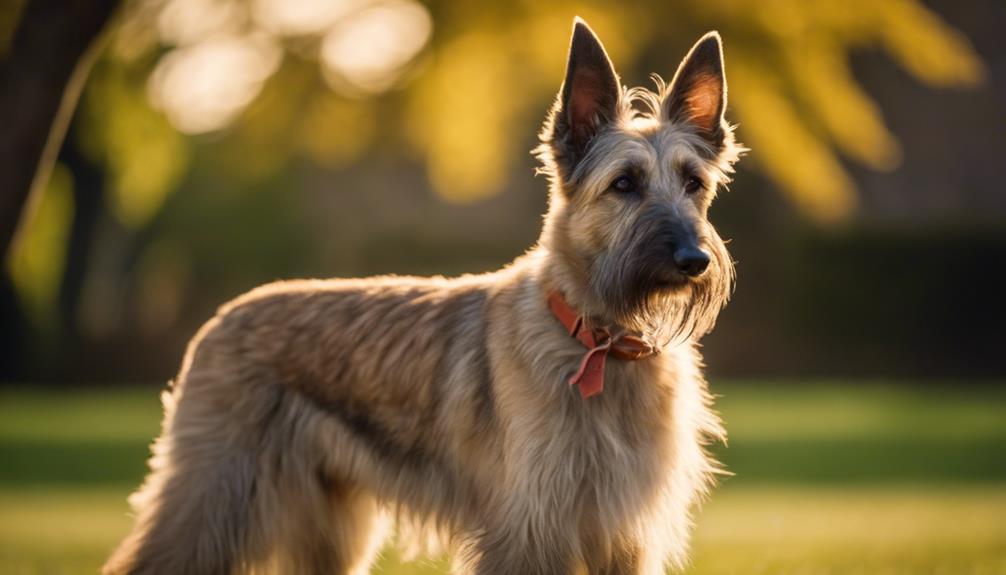
Caring for a Berger Picard, a medium-sized dog, involves more than just love and attention. Understanding their health and lifestyle needs is key to their wellbeing. It’s vital to keep an eye on their weight, ensuring they stay within a healthy range to avoid issues like obesity or malnutrition. Regular check-ups can help you stay on track.
Exercise is another crucial part of their care. Berger Picards need daily physical activity to keep them fit and prevent boredom. Whether it’s a long walk or playtime in the yard, staying active is essential for their health.
When it comes to grooming, this breed has specific needs. Regular brushing is important to keep their coat in good condition and to minimize shedding. However, they don’t require frequent baths, making their grooming routine relatively easy to manage.
Their living environment also needs consideration. Berger Picards thrive in spaces where they can move freely. A home with a yard is ideal, but regular visits to the park can also suffice. It’s all about making sure they have enough space to explore and expend energy.
Ideal Weight Range
For Berger Picards, keeping males within a 50-70 pound weight range and females between 35-55 pounds is crucial for their health. Keeping your dog within these weight limits is key to ensuring they live a long, healthy life.
A balanced diet and regular exercise, as recommended by a vet, are vital for managing their weight effectively. Checking their weight regularly helps catch any weight gain early, preventing diseases related to obesity and improving their life quality.
It’s important for pet owners to actively monitor their health, adjusting their food and exercise as needed to keep them in the best shape. This approach helps avoid health issues related to being overweight.
Exercise Requirements
Berger Picard dogs, a medium-sized breed, need daily exercise to stay healthy and happy. Walking, running, hiking, and playing are great ways to keep them in shape and prevent weight gain. These activities also strengthen their muscles and keep their minds active.
Using their natural herding skills in activities like agility training is excellent for their physical and mental health. Without enough exercise, Berger Picards might start showing unwanted behaviors. Regular activity is crucial for their overall well-being and to keep them balanced.
Grooming Tips
Caring for a Berger Picard’s coat is pretty straightforward due to its low-maintenance nature. A quick brush now and then helps avoid tangles and keeps it looking fresh. The unique wiry and weather-resistant coat of the Berger Picard provides excellent protection against various weather conditions, eliminating the need for frequent baths. This breed’s coat naturally wards off dirt and doesn’t smell bad, making grooming more about untangling and cleaning out any caught debris.
Regular brushing sessions play a crucial role in keeping the dog’s skin healthy and ensuring its coat maintains its protective and insulating properties. The simplicity of grooming a Berger Picard highlights the breed’s easy-going nature and its simple care needs.
Living Space Needs
Understanding how to care for a Berger Picard‘s grooming needs is essential when considering their living space, especially if you’re thinking about keeping one in an apartment. This medium-sized dog can adapt well to apartment life as long as it gets enough exercise. This helps prevent any issues with neighbors due to the breed’s high energy levels. Unlike some small, energetic dogs, a Berger Picard can do well in smaller spaces if you train them properly. This training should cover how to respect space at home, walk well on a leash, and control barking.
It’s also key to remember that the Berger Picard needs regular human contact to stay happy and healthy. They are not suited to living outdoors all the time. Ensuring they have consistent interaction and are part of your daily life will help them thrive, even in a smaller apartment.
Health Concerns
The Berger Picard is generally a healthy dog breed, but like all breeds, they have their own set of health issues to watch out for. These include hip dysplasia and progressive retinal atrophy. Owners and breeders need to be proactive in screening for these conditions to ensure the health and longevity of their dogs.
Hip dysplasia involves a malformation of the hip joint that can lead to arthritis, making early diagnosis through x-rays crucial. On the other hand, progressive retinal atrophy affects the eyes, which is why breeders often test the eye health of their dogs. These tests help maintain the breed’s typical lifespan of 12 to 14 years.
Getting involved with the Canine Health Information Center (CHIC) program is a smart move for breeders and owners. It helps gather valuable health data for the breed. Making sure your Berger Picard gets regular health checks and has a CHIC number is key to keeping them healthy and happy throughout their life.
Loyal and Energetic Nature
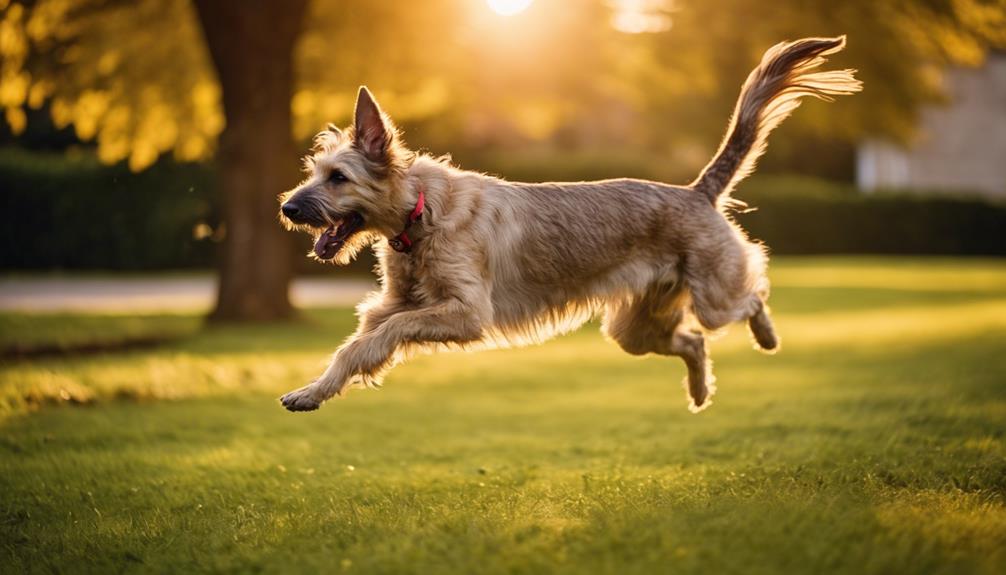
The Berger Picard is a breed known for its deep loyalty and vibrant energy, making its care and training a bit of a balancing act. These dogs form tight bonds with their families, highlighting the need for them to start socializing early on. They also have a lot of energy to burn, which means they need regular, structured exercise to stay happy and well-behaved. Their smarts add an interesting twist to training; they can learn quickly but sometimes prefer to do things their way. Positive reinforcement is the way to go with them.
- Loyalty Traits: They grow very attached to their families, so it’s crucial to get them used to being around different people and environments early.
- Energy Needs: A daily dose of high-intensity exercise is critical for their well-being.
- Training Approach: They’re bright but may show an independent side, making it important to keep training engaging and rewarding.
- Preferred Activities: They love to participate in dynamic activities like agility, herding, or a simple game of fetch, which not only keeps them fit but also strengthens your bond.
The Berger Picard’s unique blend of affection and liveliness means they thrive with attentive care and plenty of physical activities. Starting socialization early and sticking to a routine of engaging exercises can help channel their energy positively. Their intelligence, while a boon, also means they might try to outsmart you during training sessions. However, with patience and positive reinforcement, training can be a rewarding experience. Engaging them in their favorite activities not only meets their exercise needs but also deepens the connection between you and your dog.
Traits of Loyalty
Berger Picards are known for their deep loyalty, showing a strong bond with their owners. They are full of energy and show their love in many ways, which makes them great for both work and as family pets.
Their loyalty comes from their genes, making them very in tune with their owners’ emotions and needs. This makes them not just great workers but also loving companions at home. Their mix of loyalty and liveliness makes them valuable friends.
High Energy Levels
Berger Picards are known for their loyalty and high energy levels. They need plenty of exercise and mental stimulation to stay healthy and happy. This breed loves to stay active, making it essential for their owners to keep them engaged with regular physical activities and brain games. Activities like canine sports are great for using up their energy in a positive way, helping to prevent unwanted behaviors and keep their minds sharp.
Owners should ensure that their Berger Picards get a mix of exercise and mental challenges. This balance is key to managing their lively energy and ensuring they lead a fulfilled life. Proper training and socializing from a young age can help in controlling their enthusiasm and making them well-adjusted pets. This approach not only benefits the dog’s well-being but also strengthens the bond between the dog and its owner.
Training Challenges
Berger Picards are known for their loyal and lively nature but can be a bit stubborn and independent. This makes training them a bit of a challenge. It’s crucial to start getting them used to different people and situations early on, and always use positive rewards when they do something well. Despite their tendency to want to do things their own way, their smarts and knack for solving problems mean they can pick up on things quickly. They just need steady and patient coaching.
Since they were originally bred for herding, incorporating activities that play into this instinct can really grab their attention and make learning more fun for them. Keeping their training engaging by mixing in activities that challenge their minds and bodies is key. This approach not only helps with training but also taps into their natural abilities and needs, making the whole process more enjoyable for both the dog and their trainer.
Exercise Requirements
The Berger Picard dog breed is known for its loyalty and high energy. To keep them happy and healthy, they need plenty of exercise. This can include activities like running, hiking, and playing fetch every day. Without enough physical activity, these dogs may start barking too much or chewing on things they shouldn’t.
It’s helpful to mix in interactive games and training sessions to meet their exercise demands. This not only keeps them physically fit but also sharpens their minds. Ignoring their need for regular exercise can negatively affect their health and happiness. It’s crucial for anyone considering a Berger Picard to be ready for an active lifestyle with their pet.
Bonding Activities
Participating in bonding activities is key for making the most of the Berger Picard’s enthusiastic and loyal nature. This not only supports their mental health but also builds a stronger bond between the dog and its owner through positive practices and well-structured interactions. Since Berger Picards come from a herding background, they enjoy activities that challenge their minds and bodies.
Agility training and obedience competitions are great for them. These activities are similar to herding tasks, requiring quick thinking and physical effort, which suits their natural skills perfectly. Such challenges help in establishing a strong communication link between the dog and its owner.
Regular interactive play that taps into their herding instincts greatly improves the relationship. It creates a space where both the dog and the owner can understand and respect each other better.
Hip Dysplasia Prevalence
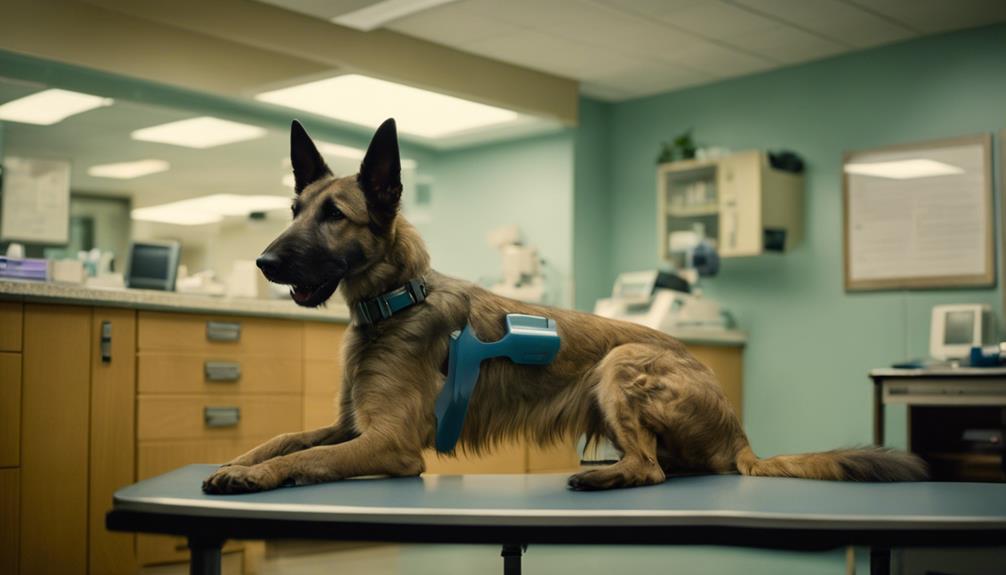
Hip dysplasia in Berger Picards is a complex condition where the hip joint doesn’t form correctly, leading to mobility problems. Catching it early through genetic tests and regular check-ups is key to managing it well. Tackling hip dysplasia involves a mix of prevention, treatment options, and changes in the dog’s daily life to help them stay comfortable.
Both genetics and the dog’s environment play roles in the risk of hip dysplasia. To prevent it, breeders should use selective breeding and keep dogs at a healthy weight. Treatments can vary, from physical therapy to surgery, depending on the case. Making sure a dog has the right amount of exercise and a good diet is also crucial for dogs with this condition.
Causes of Hip Dysplasia
Understanding the causes of hip dysplasia in Berger Picards is key because it’s often linked to their genes, how they live, and their environment. This condition makes the hip joint develop wrongly, leading to instability.
Genes play a big role, as dogs with hip dysplasia usually have it run in their family. This suggests the disease is passed down through many genes.
Things like growing too fast, being overweight, and not eating right can also make hip dysplasia worse. That’s why it’s important for breeders to do regular health checks and genetic tests. This helps them know which dogs might pass on the disease. Catching the condition early is vital for treating dogs and making sure they live a comfortable life.
Keep these dogs on a healthy diet and make sure they don’t gain too much weight. This can lower their risk. Also, giving them the right amount of exercise helps keep their joints healthy. When breeders pay attention to these details, they can help reduce the chance of puppies developing hip dysplasia.
Preventive Measures
To help reduce the occurrence of hip dysplasia in Berger Picards, it’s vital to keep up with regular health check-ups and genetic tests. This includes getting hip health certifications from trusted breeders. Joining the Canine Health Information Center (CHIC) program is a great way to keep track of and try to stop hip dysplasia with a planned approach. Spotting the signs early and taking the right steps quickly is key to making sure these dogs live a comfortable life.
Responsible breeding practices, like genetic testing, play a major role in cutting down the chances of hip dysplasia being passed on. These actions show how taking steps early and using science-backed methods can fight against hip dysplasia. This highlights why it’s so important to focus on preventing the condition from happening in the first place.
Treatment Options
Preventing hip dysplasia in Berger Picards is key, but given its 15% prevalence rate, exploring all treatment options is crucial. This condition requires a mix of treatments including medication and lifestyle changes.
Pain relief and reducing inflammation might involve prescribing NSAIDs. Managing the dog’s weight and engaging in physical therapy can help reduce joint stress and improve muscle strength. In severe cases, options like hip replacement surgery or femoral head ostectomy might be necessary.
Catching the condition early through regular check-ups and promoting healthy breeding practices can significantly lessen the severity of hip dysplasia. This not only helps in managing the condition but also in ensuring a better quality of life for the dogs affected.
Grooming and Exercise Needs
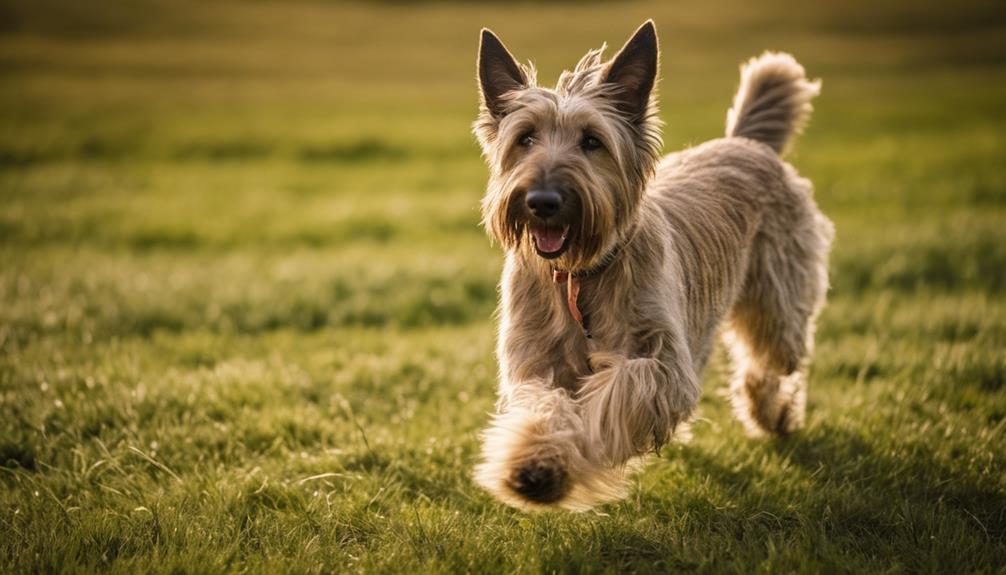
Maintaining the health and happiness of a Berger Picard involves a dedicated grooming and exercise routine. Their thick coats and boundless energy mean they need both regular brushing and plenty of physical activity. Without proper care, their fur can easily become tangled, and without enough exercise, they may develop unwanted behaviors due to boredom.
Coat Maintenance and Active Living are crucial. Regular brushing keeps their coat in good condition, preventing mats and tangles. As for keeping them active, daily walks, runs, or play sessions help manage their high energy levels.
When it comes to shedding, regular grooming sessions can help manage loose fur. Choosing the right grooming tools, like a quality brush or comb, makes a big difference in keeping their coat healthy and looking its best.
Grooming Supplies should be chosen with care. Quality brushes and combs designed for thick coats can make grooming sessions more efficient and comfortable for your dog.
Coat Care Essentials
Caring for the Berger Picard‘s coat is pretty straightforward, mainly needing just a bit of brushing now and then to avoid tangles and keep it looking good. This dog’s coat is special because it’s easy to take care of but still protects them well during activities like herding, thanks to its ability to withstand bad weather.
Keeping the coat in top condition means not bathing your dog too much. Washing them too often can remove the natural oils from their coat, making it less effective at staying clean and smelling fresh. A simple grooming routine is all it takes to maintain the coat’s natural characteristics, which is key for the health and appearance of a Berger Picard.
Daily Exercise Routines
Talking about taking care of Berger Picards, it’s important to focus on their daily exercise needs for their best health. These dogs need a mix of physical activities and brain games every day to stay fit and happy. They should go on long walks or runs, and doing agility training can really help their physical skills. It’s also key to keep their minds active with toys that make them think, training sessions, and playing games together. This keeps their brains sharp and stops them from getting bored.
Mixing up their activities with things like hiking, swimming, and playing fetch fits well with their energetic nature and love for exploring new things. Making sure they get this varied kind of exercise regularly is crucial for their physical and mental health.
Managing Shedding Challenges
To tackle the shedding challenges that come with the Berger Picard‘s unique coat, keeping up with grooming and exercise is key. Brushing them once a week helps to get rid of any loose hair and stops their coat from matting. This not only keeps them looking good but also helps to keep your house hair-free.
Getting your dog moving every day, through either walks or playtime, reduces the amount of hair they shed due to stress. This is because regular exercise keeps them both physically and mentally healthy. Feeding them a nutritious diet also plays a big role in keeping their skin and coat in top condition, which means less shedding.
Working with a professional groomer can take your shedding management to the next level. They can offer specialized treatments and advice to keep your dog’s coat healthy. It’s best to find a groomer through a trusted breeder who knows exactly what your Berger Picard needs. This approach ensures your dog stays happy and your home stays as fur-free as possible.
Ideal Grooming Tools
For those with a Berger Picard, keeping their coat smooth and healthy is key. A slicker brush and a detangling comb are great choices for this breed. The slicker brush helps get rid of dead hair and spreads the dog’s natural oils throughout their coat, making it more resistant to bad weather and giving it a nice shine.
The detangling comb is crucial for stopping knots that can irritate the skin and ruin the coat’s ability to protect the dog.
Using these tools regularly helps keep the Berger Picard looking good and feeling comfortable.
Activity Level Matching
Understanding the Berger Picard‘s activity and grooming needs is crucial for their happiness and health. This breed comes from a herding background, so they need plenty of exercises like walking, playing, and mental challenges to prevent boredom and behavioral problems. Their coat is wiry and doesn’t need much grooming, just regular brushing to keep their skin healthy and clean.
Activities like agility or herding competitions are great for them, offering both mental and physical stimulation.
Keeping up with these exercise and grooming routines is important for a happy and balanced life for the Berger Picard.
Dietary Requirements

When it comes to ensuring the health and wellbeing of Berger Picard dogs, understanding their dietary needs is key. A detailed look at their nutritional requirements helps in choosing the right food, which should be rich in quality protein and have the correct number of calories to keep them at a healthy weight. It’s important to consult with a vet to create a diet plan that suits the specific needs of your dog, based on their age, size, and how active they are.
- Nutritional Needs Analysis
- Recommended Food Types
- Managing Weight Control
- Veterinary Consultation
For Berger Picard dogs, or any dog breed, picking the right diet affects their overall health. Foods that are high in good proteins are essential. They help your dog stay strong and lively. Keeping an eye on the calories is also important to prevent weight gain, which can lead to health issues.
Talking to a vet helps customize your dog’s diet. They can consider your dog’s unique factors like age and activity level. This ensures your dog gets exactly what they need for their health and energy levels.
Nutritional Needs Analysis
Berger Picards need a diet packed with high-quality proteins to help them build muscle and keep up with their high energy levels. Their active nature means they also need a balanced mix of vitamins, minerals, and carbohydrates for energy.
It’s best to split their food into two or three meals a day to avoid bloating or obesity, which can be problems for this breed. Keep table scraps and too many treats out of their diet to help them stay in great shape and healthy.
Always check with a vet to get the meal sizes right for your dog’s age, weight, and how active they are. Making sure they always have fresh water to drink is key for keeping them well-hydrated and healthy.
Recommended Food Types
Choosing the right diet for a Berger Picard is essential. You should look for high-quality dog food that matches their size, how much they move, and their energy levels. A good diet includes plenty of lean proteins to help keep their muscles strong and support their active lifestyle. Healthy fats, like omega-3 fatty acids, are important for keeping their skin and coat looking great.
It’s also vital to make sure they get all the vitamins and minerals they need for overall health and to avoid nutritional deficits. It’s best to stay away from feeding them human food that’s rich in fats, sugars, or artificial additives, as these can lead to health problems. Talking to a vet about the best feeding routine and how much to feed your Berger Picard will help make sure they’re getting everything they need. Always make sure they have plenty of fresh water to keep them hydrated and healthy.
Managing Weight Control
For Berger Picards, a breed known for its energy, maintaining a healthy weight is crucial. Their diet needs to be closely monitored to match their age, how much they exercise, and their size. It’s all about finding the right balance of good quality dog food that meets their energy demands. Keeping an eye on how much they eat is key to preventing weight gain. This means measuring their food accurately and understanding what their body needs to stay fit.
Consulting a vet can help pinpoint the exact amount of calories they need each day, creating a diet that’s just right for them. It’s also important to be careful with treats, as giving too many can lead to extra pounds. On top of a balanced diet, regular exercise is vital. It not only burns off excess calories but also keeps them physically and mentally healthy.
Frequently Asked Questions
Are Berger Picards Good Family Dogs?
- Berger Picards are smart and obedient, great for homes.
- They adapt well to family life.
- Known for being sensitive and friendly with kids.
What Kind of Dog Was Winn-Dixie Berger Picard?
- Berger Picard stars as Winn-Dixie in the movie.
- Movie showcases breed’s unique looks and personality.
- Ensures authentic representation of the dog’s breed on screen.
What Breeds Make a Berger Picard?
- Berger Picard is a pure breed, not mixed.
- Originates from France, showcasing a unique heritage.
- Closely related to the German Shepherd according to research.
Is the Berger Picard a Working Dog?
- Berger Picard excels in herding and agility tasks.
- Known for exceptional intelligence in problem-solving.
- Demonstrates physical dexterity in work-related activities.

